Text: AAron Hutchins
Photos by: Alex Hutchins (click on the pics to make them bigger. More pics, including plaques that explain HTRE, in the Galleries section, click on the INL Nuclear Power Site)
Barely noticeable from the two lane highway, sitting literally in the middle of nowhere, a brick building with some strange caged objects next to it. Getting any closer doesn’t help you identify the metallic two story tall objects, behind locked fences with barbed wire on top. They seem extraterrestrial. Perhaps some ancient Alien visitors left behind their space vehicle?
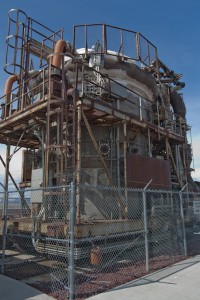
HTRE-3
It’s like something out of X-Files. But this isn’t Area 51, in Nevada. It’s not Roswell, New Mexico. It’s eastern Idaho, and today is windy and cold. As my son Alex said, “It’s Big Wind.”
As far as ‘ancient’ goes, well, some people might think 1950s is ancient. That’s when the strange twisted metal craft first appeared. Extraterrestrial? Many people in the 1950s thought the scientists of the day were out of this world with their crazy ideas, like nuclear powered jet aircraft.
Taking Exit 93 off Interstate 15, turn west towards Arco. Stay on Highway 26 for about 40 miles. As you drive the lonely 40 miles you’ll pass the big “Welcome to the INL” sign. Then you’ll come to an intersection, make a left, just follow the arrows to Arco. You’ll see building complexes to your right, that’s part of the main Idaho National Laboratory complex.
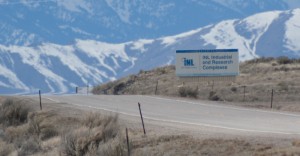
INL Entrance
At that point pay attention to your left. You should see a lone building in the distance, EBR-1, the world’s first nuclear reactor. That’s where the strange alien vehicle looking things are. There should be a left turn lane coming up, with signs for EBR-1. Make the turn, then another left turn lane, again follow the sign for EBR-1.
It’s a desolate place, my son and I were the only ones there that windy, cold day. We passed a couple of parked cars on the roadside, with no one in them, out in the middle of nowhere, mmm.
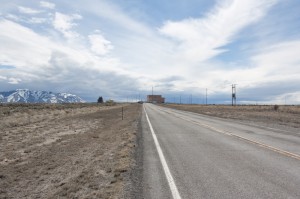
EBR-1
There they are, like something left behind, and forgotten, by some advanced species, in the middle of the vast, windy East Idaho desert, HTRE-1, 2 & 3. The three huge Heat Transfer Reactor Experiments units making up world’s first nuclear powered turbine engine. Intentionally twisted metal, big pipes, gigantic turbos, and two little jet engine exhaust at the back. Don’t think these guys are safe, they’re radiation warning signs all over. Many of the openings and fittings are sealed off. Even the giant weld seams on the reactor have been recently coated with a white colored material.
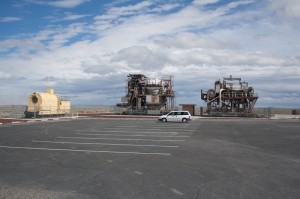
Nuclear powered jet engines and the lead-lined train that pulled them.
Some people would say that only an evil scientist would come up with such a thing. Maybe they’re right? General Electric spent one billion taxpayer dollars on the project, before it was canceled by President Kennedy in 1961. And that’s 1950s dollars, whew!
There are several informational plaques that give the visitor more understandable, and more interesting, info than what I found on the internet. Like “Operation Wiener Roast”. They actually burned a nuclear turbine engine to see if dangerous levels of radiation would be spread if a nuclear powered aircraft crashed.
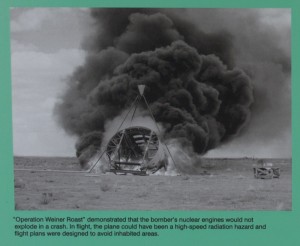
Operation Wiener Roast
Testing of the reactor turbine was successful, but an actual aircraft was never developed. The program was conducted in Idaho, in Test Area North, of what is now called the INL. The project was managed by the U.S. Air Force and the Atomic Energy Commission. There’s lots more information on the signs, you need to go there to look for yourself.
One things for sure, this archeological find proves that the U.S. government spent taxpayer dollars on some really far out stuff in the 1950s.
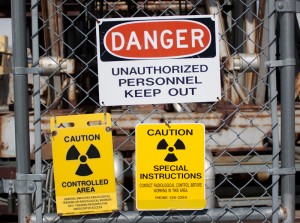
Radiation signs next to jet engines.
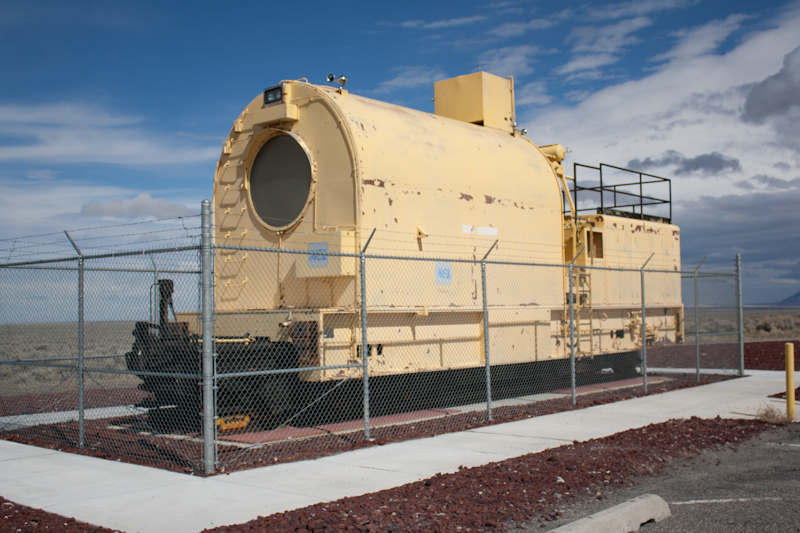
Lead-lined train in the Arco desert in Eastern Idaho. Photo by Alexander Hutchins.
GHOSTLY NUKE TRAIN ROLLIN’ ‘CROSS IDAHO DESERT








